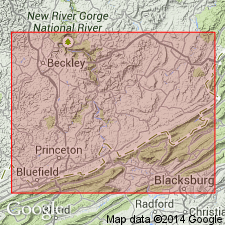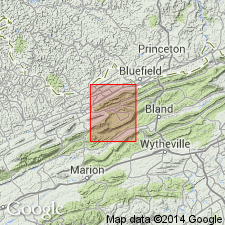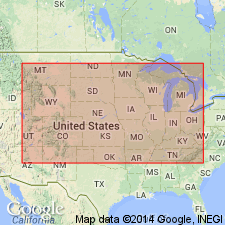
- Usage in publication:
-
- Bent sandstone
- Modifications:
-
- Original reference
- Dominant lithology:
-
- Sandstone
- AAPG geologic province:
-
- Appalachian basin
Summary:
Pg. 293, 315. Bent sandstone. Greenish brown, micaceous, flaggy or shaly ledge, usually 40 to 60 feet thick. Lies 50 to 200 feet below top of Bluestone group [Bluestone formation]. Rests on Upper Bent shale. Type locality is on Bent Mountain (Mercer Co., 1.2 mi southeast of Pride), where it is 55 feet thick. Recognized in southeastern West Virginia. Age is Mississippian.
[The Bluestone group is a term used by some geologists to include same rocks as Bluestone formation of USGS reports (US geologic names lexicon, USGS Bull. 896, p. 222).]
Source: US geologic names lexicon (USGS Bull. 896, p. 163).

- Usage in publication:
-
- Upper Bent shale
- Lower Bent shale
- Modifications:
-
- Original reference
- Dominant lithology:
-
- Shale
- AAPG geologic province:
-
- Appalachian basin
Summary:
Pg. 293, 315-316. Upper Bent shale immediately underlies Bent sandstone member of Bluestone group and is separated from Lower Bent shale by Bent limestone, 0 to 1 foot thick. All belong in Bluestone group [Bluestone formation]. Upper Bent shale is sometimes red and variegated, and sometimes black and fissile, 20 to 40 feet thick, and contains marine fossils. Its type locality is on Bent Mountain (Mercer Co., 1.2 mi southeast of Pride), where it is red and green and 55 feet thick. The Lower Bent shale is green, argillaceous, and fissile, and carries marine fossils. It was not seen in Mercer, Monroe, and Summers Counties, West Virginia, but is visible in Tazewell County, Virginia, about 1 mile northwest of Bailey Station; thickness 6 to 18 feet. Age is Mississippian.
[The Bluestone group is a term used by some geologists to include same rocks as Bluestone formation of USGS reports (US geologic names lexicon, USGS Bull. 896, p. 222).]
Source: US geologic names lexicon (USGS Bull. 896, p. 163-164).

- Usage in publication:
-
- Bent limestone
- Modifications:
-
- Original reference
- Dominant lithology:
-
- Limestone
- AAPG geologic province:
-
- Appalachian basin
Summary:
Pg. 293, 316. Bent limestone. A thin lenticular horizon, 0 to 1 foot thick, named for its association with Upper Bent shale. Contains ostracods. Is a member of Bluestone group [Bluestone formation]. Presence not noted in Mercer, Monroe, and Summers Counties, West Virginia, but is visible in Tazewell County, Virginia, on a cross road that passes Bailey Station northwest to Mud Fork of Bluestone River, the outcrop being on the Mud Fork side of the ridge and about 1 mile from the station, where it lies between Upper Bent shale and Lower Bent shale. Age is Mississippian.
[The Bluestone group is a term used by some geologists to include same rocks as Bluestone formation of USGS reports (US geologic names lexicon, USGS Bull. 896, p. 222).]
Source: US geologic names lexicon (USGS Bull. 896, p. 164).

- Usage in publication:
-
- Bent Mountain member
- Modifications:
-
- Principal reference
- Dominant lithology:
-
- Shale
- Sandstone
- Limestone
- AAPG geologic province:
-
- Appalachian basin
Summary:
Pg. 186, pl. 15. Bent Mountain member, as herein defined and used, consists of four of Reger's (1926, p. 293, 315-316) subdivisions of the Bluestone, Lower Bent shale, Bent limestone, Upper Bent shale, and Bent sandstone. In area of report, Burkes Garden quadrangle, Reger's Bent sandstone is not present. Member consists of only lower 60 feet of member as developed at type locality; most of the 60-foot section is red and green shale and mudrock. Overlies Hunt member (new). Reger's Lower Bent shale and Bent limestone are same as his Upper Bent shale. Double thickness of Upper Bent shale, produced by close folding, is exposed along Road 656 about 1.5 miles north of Bailey; here, Reger, apparently mistook the repeated Upper Bent shale for his Lower Bent shale and Bent limestone. Bent Mountain member recognized in southeastern West Virginia and southwestern Virginia. Age is Late Mississippian (Chesterian).
Type locality: on Bent Mountain, Mercer Co., WV, 1.2 mi southeast of Pride, WV (Reger, 1926).
Reference cited: Reger, D.B., 1926, West Virginia Geol. Survey Rpt. Mercer, Monroe, and Summers Counties.
Source: US geologic names lexicon (USGS Bull. 1200, p. 303, 304).

- Usage in publication:
-
- Bent Mountain beds
- Bent beds
- Modifications:
-
- Overview
- AAPG geologic province:
-
- Appalachian basin
Summary:
Chart 5 (columns 97, 98). Shown on correlation chart as Bent Mountain beds (or Bent beds) in Bluestone formation or group.
Source: US geologic names lexicon (USGS Bull. 1200, p. 304).
For more information, please contact Nancy Stamm, Geologic Names Committee Secretary.
Asterisk (*) indicates published by U.S. Geological Survey authors.
"No current usage" (†) implies that a name has been abandoned or has fallen into disuse. Former usage and, if known, replacement name given in parentheses ( ).
Slash (/) indicates name conflicts with nomenclatural guidelines (CSN, 1933; ACSN, 1961, 1970; NACSN, 1983, 2005, 2021). May be explained within brackets ([ ]).

